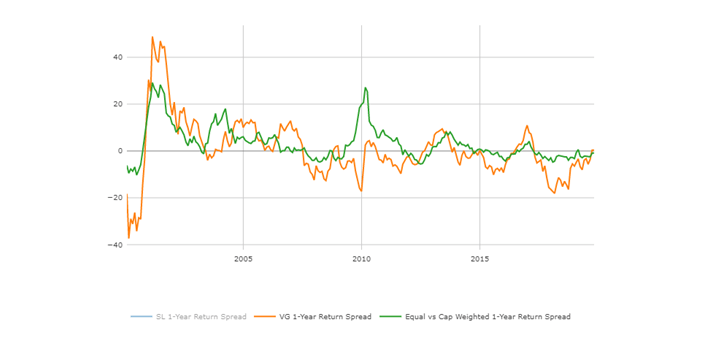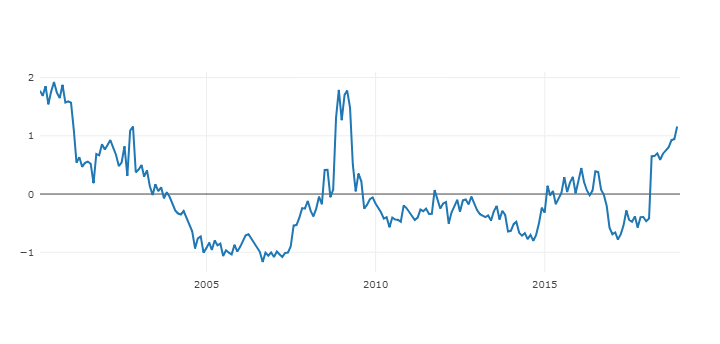
US economics, inflation, and the Fed
The pace of price growth accelerated in January, ending the downward trend witnessed during the final months of 2023. Indeed, hotter-than-expected readings on consumer prices were followed by higher inflation at the producer (wholesale) level. The January Producer Price Index (PPI) and core PPI rose 0.3% and 0.6% on a month-to-month basis, respectively, handily topping the consensus forecasts. While this may prove to be a temporary hiccup in the Federal Reserve’s battle to tame inflation, it could force the bank to keep the federal funds rate high for a while longer according to Value Line.
Professor Siegel (who just recently retired from Wharton Business School) is not worried about the hot Consumer Price Index (CPI) nor the Producer Price Index (PPI):
“Commodity indices, particularly the Bloomberg Commodity indices, are still near new their lows. Sensitive commodities are the early warning signals of inflation, and they are quiet. I expect a reversal in February of the above-expectations inflation report we had earlier, mainly because of quirks in the shelter index. Everyone is trying to predict when the Fed will make its first cut. But that is not critical —the Fed is dependent on the data and, if the economy weakens, they will cut rates.”
Indeed, the Fed must guard against staying too high for too long and risk causing dysfunction in parts of the economy, particularly in the rate-sensitive regional bank, commercial real estate, and housing sectors. On the last front, January housing starts fell short of both the consensus expectation and the prior month’s tally according to Value Line. This scenario puts extra focus on the January Personal Consumption Expenditures (PCE) Price Index. That reading, which rose by 0.3% in January in line with expectations, is the assessment of inflation most closely monitored by the Federal Open Market Committee (FOMC). From a year earlier, the PCE Price Index has gone up by 2.4% — closing in on the Fed’s 2% annual target — very good news for the market!
Global economy
The global economy has displayed impressive resilience in the face of aggressive monetary tightening thus far with GDP rising 2.9% over the past four quarters according to JP Morgan. However, global growth engines have been relatively concentrated. Demand rose strongly relative to the trend last year in the US and emerging markets ex. China, whereas the Western Europe expansion stalled. The key sectoral driver of growth remained the services sector, whereas manufacturing output has been stagnant for more than 12 months outside a second half of the year tech-fueled rebound in Asia. JP Morgan believes that global growth is poised to moderate to a trend pace during the first half of 2024, as US consumer and global tech spending gains cool.
Higher energy prices and core inflation look likely to promote a downshift in US consumption from its robust 3.6% per annum gain in the previous six months. As the US consumer cools, JP Morgan looks for an offset from Western Europe where falling inflation and elevated wage gains are boosting purchasing power.
Stock market: Earnings season 4Q 2023
With 88% of S&P 500 companies having reported, 71% are beating 4Q earnings (in line with the avg. last 4Qs): and 63% are beating revenue estimates (vs. 64%). Notable standouts in terms of earnings beats so far this quarter include Staples, Technology, and Healthcare according to JP Morgan.
Surprise/Growth. S&P 500 companies so far have surprised on net income by 5.3% (vs. 2.9% last 4Qs, ex-Financials at 6.3%). For companies that have reported, 4Q revenue growth is 3.8% y/y and net income growth is 7.9% (vs. 8.6% ex Financials). Earnings surprise (% contribution) was largely driven by Technology (29%), Discretionary (20%), and Industrials (17%).
Stock market: Earnings total year 2023
Empirical Research Partners note that “the earnings per share of the S&P 500 increased by +2% in 2023 and by +6% ex-energy. The top line, ex-energy, expanded by +4.5%, benefiting from a nominal GDP growth rate of +6.25%. The earnings gains were better in the fourth quarter, up +6% overall and +11% ex-energy, on top-line growth of +5.5%. The bottom-up estimates for 2024 envision an +8.5% earnings gain, a plausible expectation, all things considered.
The big inventory cycle that peaked in the middle of 2022 has run its course, and inventories were flat in the fourth quarter. The post-pandemic boom in capital spending has also lost steam and expenditures were up by +3% in the latest period. Input costs have gone from a powerful headwind to a minor tailwind, and the uptrend in labor costs is no longer outstripping that in the top line. The moderation of the cost pressures is showing up in the breadth of earnings gains, and despite the higher cost of debt funding, most companies saw their margins increase in the fourth quarter.
The tech and interactive media sector have been at the heart of both the market’s earnings and multiple stories, for at least 20 years now. The sector’s net margin was 8% in 2004 and last year it reached 21%, while that for the market as a whole climbed from 6% to 7.5%. Tech’s share of S&P 500 earnings expanded from 10% two decades ago to 26% now. Much of the increase in the market’s forward multiple, which currently tops 20 times, can be chalked up to the mix shift. As goes tech goes the market, and so far, its (bullish) earnings trend is intact.”
Signet’s forecast
Signet’s proprietary 12-month forward forecast shows a solid path for Technology. In our work, we combine macro data and market aggregates on the macro end and bottom-up company fundamentals on the micro end. Such a favorable forecast for Technology makes us optimistic about the market prospects going forward!

The information and opinions included in this document are for background purposes only, are not intended to be full or complete, and should not be viewed as an indication of future results. The information sources used in this letter are: WSJ.com, Jeremy Siegel, Ph.D. (Jeremysiegel.com), Goldman Sachs, J.P. Morgan, Empirical Research Partners, Value Line, BlackRock, Ned Davis Research, First Trust, Citi research, HSBC, and Nuveen.
IMPORTANT DISCLOSURE
Past performance may not be indicative of future results.
Different types of investments and investment strategies involve varying degrees of risk, and there can be no assurance that their future performance will be profitable, equal to any corresponding indicated historical performance level(s), be suitable for your portfolio or individual situation, or prove successful.
The statements made in this newsletter are, to the best of our ability and knowledge, accurate as of the date they were originally made. But due to various factors, including changing market conditions and/or applicable laws, the content may in the future no longer be reflective of current opinions or positions.
Any forward-looking statements, information, and opinions including descriptions of anticipated market changes and expectations of future activity contained in this newsletter are based upon reasonable estimates and assumptions. However, they are inherently uncertain, and actual events or results may differ materially from those reflected in the newsletter.
Nothing in this newsletter serves as the receipt of, or as a substitute for, personalized investment advice. Please remember to contact Signet Financial Management, LLC, if there are any changes in your personal or financial situation or investment objectives for the purpose of reviewing our previous recommendations and/or services. No portion of the newsletter content should be construed as legal, tax, or accounting advice.
A copy of Signet Financial Management, LLC’s current written disclosure statements discussing our advisory services, fees, investment advisory personnel, and operations are available upon request.



























































































